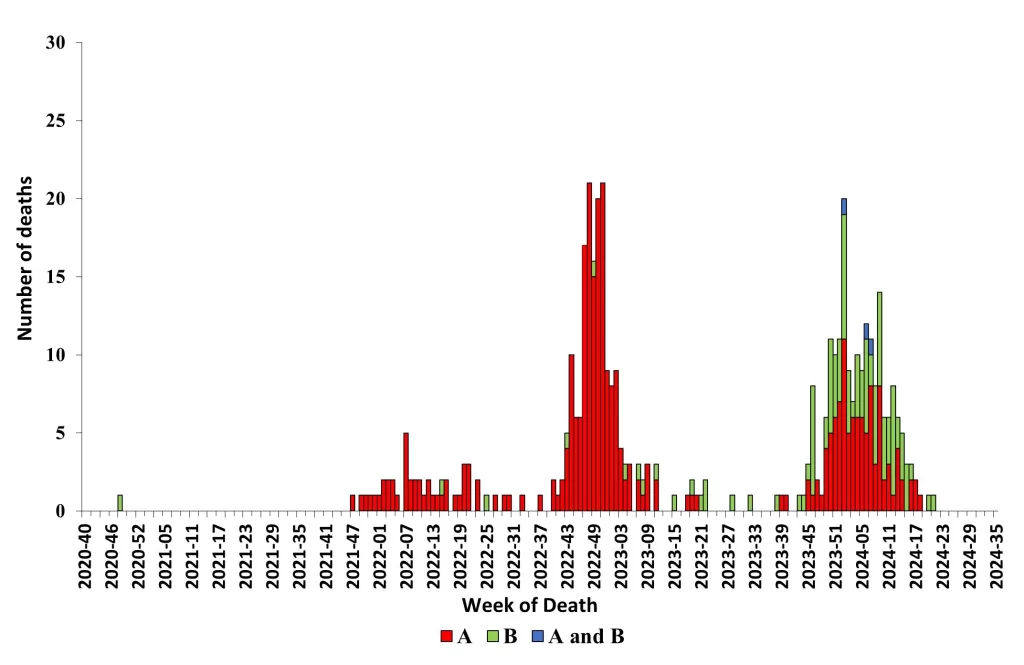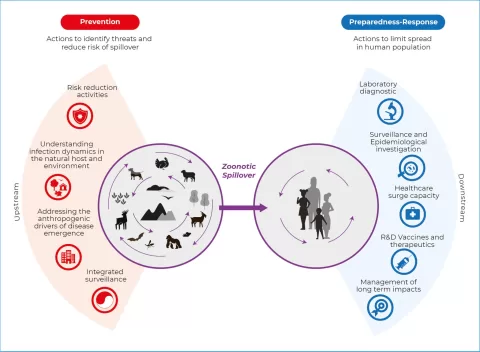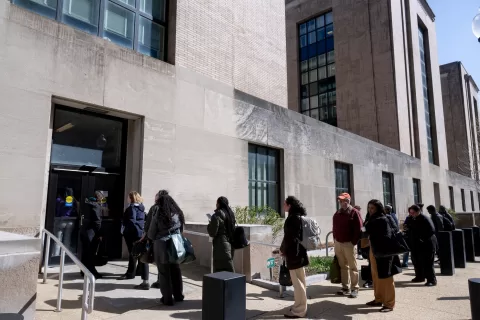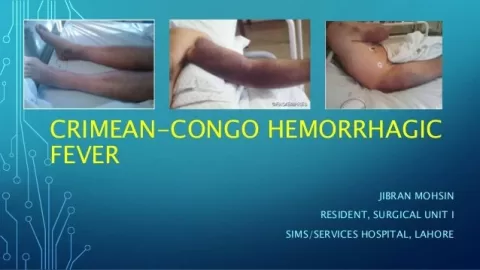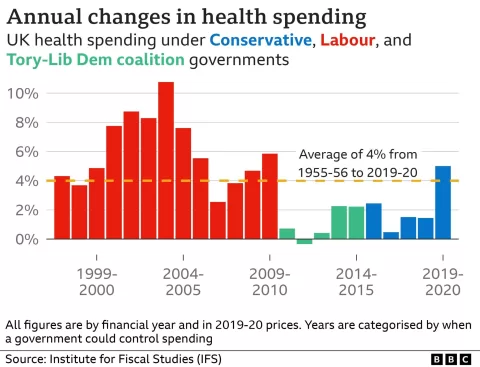Flu deaths in US kids have become a troubling statistic this flu season, as reported by the Centers for Disease Control and Prevention (CDC). With a total of 275 pediatric deaths recorded, this marks the highest number of flu-related fatalities among children in any non-pandemic year since 2004. Disturbingly, 90 percent of these tragic cases involved unvaccinated children, highlighting the crucial importance of pediatric flu vaccinations in protecting young lives. Meanwhile, the ongoing COVID-19 pandemic has significantly changed flu patterns, making it even more imperative to encourage vaccination as a preventative measure. As we examine the current health landscape, the need for vigilance against diseases like flu, chikungunya, and polio remains crucial.
The rising trend of influenza-related fatalities among young people in the United States is alarming, reflecting a serious public health concern during the current flu season. The CDC’s alarming statistics reveal that this season’s pediatric fatalities have surged, presenting a stark reminder of the risks faced by children, particularly those who are not vaccinated against the flu. Beyond influenza, the emergence of new Chikungunya cases in parts of Europe and ongoing polio outbreaks worldwide underscore the complexities of contemporary infectious disease challenges. With flu vaccinations for kids being pivotal in preventing such untimely deaths, the impact of COVID-19 on overall health behaviors warrants attention. As we navigate this intricate web of health threats, raising awareness about vaccination and disease prevention is more important than ever.
Increase in Flu Deaths Among US Children
The recent report from the CDC highlights a significant increase in flu deaths among US children, totaling 275 for the ongoing 2024-25 flu season. This marks the highest number of pediatric deaths recorded in a non-pandemic season since 2004, underlining the severity of this year’s outbreak. The data indicates that a staggering 90% of these fatalities occurred in unvaccinated children, emphasizing the crucial role of pediatric flu vaccinations in preventing severe outcomes. As the flu season continues, parents are urged to prioritize vaccinations to safeguard their children’s health.
Flu deaths in US kids reflect a broader public health challenge, particularly as we navigate the aftermath of the COVID-19 pandemic. With the healthcare system still feeling the impacts of COVID-19, many families may overlook the importance of annual flu vaccinations. The current flu season has not only resulted in tragic deaths, but it may also strain healthcare resources as hospitals face increased admissions from respiratory illnesses. This situation calls for a concerted effort from health authorities to promote vaccination campaigns and educate parents about the risks associated with influenza.
Chikungunya Cases Surge in Europe
This week, France and Italy have reported new cases of chikungunya virus disease, with France registering 45 and Italy 22 new locally acquired infections. The ECDC’s data indicates that France has a total of 156 cases, spread over 27 active clusters, signifying a worrying trend of the virus’s resurgence in Europe. The presence of the Aedes albopictus mosquito, known to transmit the chikungunya virus, has expanded significantly, now found in 16 European countries. This alarming expansion raises public health concerns regarding potential outbreaks and increased transmission rates.
The challenges posed by chikungunya highlight the interconnectedness of global health threats, particularly in the context of emerging infectious diseases. European authorities are now faced with the task of managing these outbreaks effectively while ensuring public awareness of preventive measures. With the Aedes albopictus also linked to the transmission of diseases such as dengue, a strategic approach is essential to mitigate risks associated with these mosquito-borne illnesses. Strong surveillance and mosquito control efforts must be prioritized to prevent further spread of chikungunya across Europe.
Current reports also show that vaccine trials for chikungunya are underway, and successful development of a vaccine could drastically reduce incidences of the disease in affected regions. Public health campaigns promoting personal protection measures, including the use of mosquito repellents and installation of window screens, are vital in complementing vaccination efforts to control the spread of chikungunya.
Global Polio Update: New Cases Reported
Recent updates from the Global Polio Eradication Initiative reveal new polio cases across five countries, underscoring the ongoing battle against this debilitating virus. Pakistan reported two wild poliovirus type 1 (WPV1) cases, raising its total for the year to 21. The emergence of new circulating vaccine-derived poliovirus type 2 (cVDPV2) cases in Yemen, where 26 cases have been noted, reflects the complexities associated with polio eradication efforts. The GPEI has clarified that the increase in Yemen is linked to retrospective testing rather than an actual spike in virus transmission.
With polio still posing a risk in various regions, it’s essential for global health organizations to maintain and enhance vaccination programs. As seen in other viral outbreaks, the interruptions in routine immunizations during the COVID-19 pandemic have highlighted the vulnerability of populations to vaccine-preventable diseases. Efforts must be directed towards bolstering immunization coverage to prevent outbreaks, particularly in countries experiencing civil unrest or inadequate healthcare infrastructure. Continued vigilance and support are required to ensure that polio does not regain a foothold in previously endemic regions.
The Impact of COVID-19 on Flu Patterns
The COVID-19 pandemic has had a profound impact on seasonal flu patterns, drastically changing the dynamics of influenza spread and vaccination rates. With widespread masking, social distancing, and lockdown measures, many experts observed a significant drop in flu cases during the last couple of years. However, as restrictions have eased, there are signs of a resurgence in flu activity, which poses new public health challenges. This year’s spike in flu deaths, particularly among children, can be partly attributed to the disruption of routine vaccinations during the pandemic years.
As the world adapts to the post-COVID landscape, the interplay between flu and COVID-19 will remain a topic of critical research and public concern. Medical professionals emphasize the importance of seasonal flu vaccinations this year, especially for high-risk groups such as children, the elderly, and individuals with underlying health conditions. Comprehensive education is needed to encourage vaccination uptake and prepare for possible dual infection scenarios where both flu and COVID-19 circulate simultaneously during peak seasons.
Pediatric Flu Vaccinations: A Lifesaving Measure
Pediatric flu vaccinations have emerged as a crucial tool in preventing serious flu-related illness and death in children. With the current high number of flu deaths reported this season, health authorities are reinforcing the message that vaccination can significantly reduce risks. Studies have shown that flu vaccines can lower the severity of illness, prevent hospitalizations, and decrease complications related to the virus in children. The CDC’s guidelines recommend annual flu vaccinations for all children aged six months and older, making it imperative for parents to schedule these vaccinations timely.
Moreover, public health campaigns are focusing on educating families about the safety and efficacy of pediatric flu vaccinations. With many parents concerned about vaccines due to the pandemic, it’s vital to address misinformation and provide data that highlights the benefits of flu shots. Ultimately, enhancing vaccination rates can play a significant role in safeguarding not just individual children but the broader community by contributing to herd immunity against the flu.
Mosquito-Borne Diseases: A Rising Concern
The expansion of mosquito-borne diseases, including chikungunya and dengue, has raised alarms in Europe and beyond. The recent report of chikungunya cases in France and Italy emphasizes the urgent need for robust vector control strategies to combat the Aedes albopictus mosquito’s spread. As these invasive species establish themselves in new geographic areas, the risk of outbreaks increases, putting populations at risk for severe illness. Public health initiatives must focus on educating communities about preventive actions such as eliminating standing water, using repellents, and ensuring proper home protection.
Additionally, the emergence of new mosquito-borne diseases is often compounded by climate change, which creates favorable conditions for mosquito proliferation. Policymakers and health organizations must work collaboratively to develop comprehensive surveillance systems that can track disease incidence and mosquito populations effectively. The interconnection between environmental changes and public health underscores the need for a proactive approach to mitigate risks and protect communities from the rising threat of infectious diseases.
Understanding Vaccine-Preventable Diseases
In the context of public health, understanding vaccine-preventable diseases is paramount for ensuring community health safety. The resurgence of diseases like polio, highlighted by recent outbreaks, serves as a grim reminder of the importance of vaccination programs worldwide. With numerous countries reporting new cases, the focus on maintaining high immunization rates is more critical than ever. Vaccination not only provides individual protection but also plays a significant role in achieving herd immunity, thus safeguarding vulnerable populations who cannot be vaccinated.
Furthermore, unexpected disruptions in vaccination schedules due to the COVID-19 pandemic have left many communities exposed to preventable diseases, necessitating urgent action. Health officials are urged to emphasize the significance of returning to routine vaccinations, particularly for children, who are most at risk. Public outreach and educational campaigns can help rebuild trust in vaccines and encourage families to participate in vaccination programs, ultimately preventing future outbreaks of vaccine-preventable diseases.
The Role of Surveillance in Controlling Infectious Diseases
Effective surveillance systems are crucial for controlling infectious diseases such as flu, chikungunya, and polio. The ability to monitor trends in disease prevalence and vaccination rates empowers health authorities to respond promptly to emerging threats. In the case of the recent polio outbreaks in multiple countries, robust surveillance has allowed for quick identification of cases, enabling targeted vaccination efforts to contain the virus. Similarly, the tracking of chikungunya cases is essential in understanding the spread of the diseases and implementing effective interventions.
In addition to traditional surveillance, integrating community reporting systems can enhance the ability to detect outbreaks early. By encouraging local health workers and residents to report unusual illnesses, public health agencies can activate response measures rapidly and minimize the impact of such infectious diseases. As the landscape of global health evolves, emphasizing comprehensive and adaptive surveillance strategies will be key in mitigating the effects of outbreaks and safeguarding public health.
Frequently Asked Questions
What is the current status of flu deaths in US kids for the 2024-25 season?
As of the latest report from the Centers for Disease Control and Prevention (CDC), there have been 275 influenza-associated pediatric deaths in US children during the 2024-25 flu season. This number represents the highest count of pediatric flu deaths recorded in any non-pandemic season since 2004.
How have flu deaths in US kids been affected by COVID-19?
The impact of COVID-19 on flu deaths in US kids has been significant. During the 2024-25 flu season, pediatric deaths have surged, with 90% of those who died not being fully vaccinated against the flu. Experts believe that the ongoing challenges with COVID-19 may have influenced vaccination rates and healthcare behaviors related to influenza.
What role does pediatric flu vaccination play in preventing flu deaths in US kids?
Pediatric flu vaccinations are crucial in preventing flu-related deaths in US children. The CDC has highlighted that a staggering 90% of the pediatric influenza deaths reported for the current season involved children who were not fully vaccinated. This underscores the importance of vaccinating children annually to protect against severe influenza outcomes.
Are there any warnings regarding flu deaths in US kids during the current flu season?
Health authorities are sounding alarms about the unprecedented number of flu deaths in US kids this season, emphasizing the need for increased vaccination efforts. Parents are advised to ensure their children receive the flu vaccine to help mitigate severe cases and related fatalities. The current death toll of 275 highlights the critical need for vigilance and preventive measures.
How can we further educate about flu deaths in US kids among parents?
Educating parents about flu deaths in US kids can be enhanced through outreach programs, social media campaigns, and community health initiatives. Providing clear information about the risks associated with influenza, the importance of vaccination, and updates on current flu trends will empower parents to make informed health choices for their children.
What are the implications of increased pediatric flu deaths in terms of public health?
The increase in pediatric flu deaths in the US emphasizes the urgent need for improved public health strategies. It highlights challenges in vaccination rates and public compliance. Ongoing public education campaigns and health system readiness are essential to curb further losses and protect vulnerable populations, particularly children, from influenza-related morbidity and mortality.
What preventive measures can be taken to reduce the incidence of flu deaths in US kids?
To reduce flu deaths in US kids, healthcare professionals recommend regular flu vaccinations for all eligible children, promoting good hygiene practices, and increasing public awareness about the flu’s seriousness. Encouraging families to seek medical advice promptly when flu symptoms appear can also help prevent complications.
How do health authorities track flu deaths in US kids during flu seasons?
Health authorities, including the CDC, track flu deaths in US kids through ongoing surveillance systems that record influenza-associated fatalities and related hospitalizations. Data is collected through hospitals, clinics, and state health departments, enabling a comprehensive understanding of the impact of influenza on pediatric populations.
| Key Point | Details |
|---|---|
| Flu Deaths in US Kids | The CDC reported an increase of 5 pediatric flu deaths this week, raising the total to 275 for the season, the highest since 2004. |
| Vaccination Status | 90% of the reported pediatric deaths occurred in unvaccinated children. |
| Chikungunya Cases in Europe | France reported 45 new cases while Italy reported 22 new cases of chikungunya. |
| Polio Cases Worldwide | Five countries reported new polio cases, with Pakistan documenting two cases of wild polio. |
Summary
Flu deaths in US kids have reached alarming levels this season, underscoring the critical importance of vaccination. A recent report from the CDC highlights that there have been 275 pediatric deaths from influenza in the current flu season, marking the highest number reported in a non-pandemic year since 2004. The data reveals that a striking 90% of these tragic fatalities involved children who were not fully vaccinated against the flu. This situation should serve as a wake-up call for parents to prioritize flu vaccinations to protect their children from this preventable illness.
The content provided on this blog (e.g., symptom descriptions, health tips, or general advice) is for informational purposes only and is not a substitute for professional medical advice, diagnosis, or treatment. Always seek the guidance of your physician or other qualified healthcare provider with any questions you may have regarding a medical condition. Never disregard professional medical advice or delay seeking it because of something you have read on this website. If you believe you may have a medical emergency, call your doctor or emergency services immediately. Reliance on any information provided by this blog is solely at your own risk.



